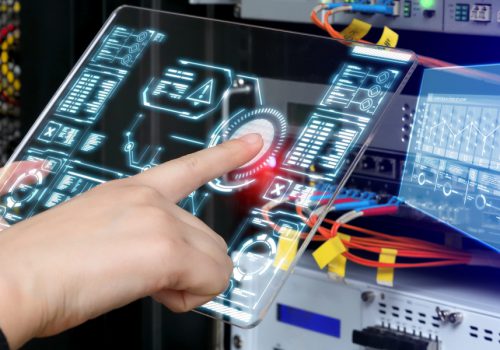DARQ, a term coined by the business consultancy Accenture, stands for Distributed Ledger Technology (DLT), Artificial Intelligence (AI), Extended Reality (XR), and Quantum Computing (QC). It represents a new group of powerful and emerging technologies that when combined and boosted by the evolving telecommunications’ technologies (5G/6G), will leverage the development of vast and innovative solutions.
Regardless of some of the technologies themselves being in existence for quite a while, the way in which they can be applied and used together has evolved, creating opportunities and threats to what the post-digital world may look like.
As more organizations have been moving forward with the digital transformation, soon it will not be considered as a business advantage, opening space for the post-digital world. More mature markets will demand new highly customized services and products and organizations will compete to fulfill the individuals in every aspect of their lives.
DARQ in a Nutshell
1. Distributed Ledger Technology
Distributed Ledger Technology (DLT) is a distributed decentralized peer-to-peer digital system for recording transactions between parties in multiple nodes simultaneously. DLT deploys cryptography and consensus mechanisms to allow participants to share an immutable replica of the same ledger. A subset of DLT implements smart contracts which are simply programs that run on the DLT when certain conditions are met.
DLT, including Blockchain technology, is on the brink of adoption by several industries leveraged by the advantages this technology offers, as shown in Figure 1, such as increased security, immutability, tamper resistance, and decentralization, therefore, responding to an everincreasing demand for transparency, traceability, and accurate data between stakeholders that cannot be trusted without relying on an intermediate.

Figure 1: DLT Characteristics and Business Needs
Figure 2 presents an overview of the DLT. Public DLTs, while being transparent and resistant to tampering, are slow, being more focused on the security and decentralization and less on the scalability, whereas private DLTs are somewhat centralized but can deliver much higher throughput and speeds, being more focused on the scalability and security and less on decentralization. Hybrid DLTs combine the benefits of both DLT types while trying to limit their disadvantages.

Figure 2: Overview of the DLT
2. Artificial Intelligence
Artificial Intelligence (AI) is the science of making intelligent machines, especially intelligent computer programs. It is related to the similar task of using computers to understand human intelligence, and computers can execute repetitive tasks with complete precision. Lately, they have been gaining the ability to learn, improve, and make decisions in ways that will enable them to perform tasks previously thought to rely on human capabilities. By automating repetitive tasks, AI is enabling staff to take on higher-value work.
An AI system combines and utilizes machine learning and deep learning and other types of data analytics methods to achieve artificial intelligence capabilities as shown in Figure 3.

Figure 3: Artificial Intelligence Overview
AI systems can be categorized based on the degree to which they can replicate human capabilities, as follows; Artificial Narrow Intelligence (ANI), Artificial General Intelligence (AGI), and Artificial Superintelligence (ASI), see more in Figure 4.

Figure 4: AI Types based on the degree to which they can replicate human capabilities
3. Extended Reality
Extended Reality (XR) is an umbrella for all the immersive technologies, including those already in place today – augmented reality (AR), mixed reality (MR), and virtual reality (VR), as shown in Figure 5, plus those that are still to be created – by extending the reality through either blending the virtual and real worlds or creating a fully immersive experience.

Figure 5: Extended Reality (XR) immersive technologies
4. Quantum Computing
Quantum Computing (QC) is the area of study focused on the development of computer-based technologies centered around the principles of quantum theory.
Quantum computing gains much of its processing power through the ability for bits to be in multiple states at one time.
In classical computing, data must be processed in an exclusive binary state at any point in time – either 0 or 1. These values are binary digits, or bits. As the circuits progress to be smaller and faster, physical limits of materials and the threshold for classical laws of physics apply and quantum computing is a new approach to fulfill these gaps.
In a quantum computer, several elemental particles, such as electrons or photons can be used. Each particle is given a charge or polarization acting as a representation of 0 and/or 1. Each particle is called a quantum bit, or qubit.
For example, a 2-bit register of a classical computer can store only one of four binary configurations at any given time, while a 2-qubit register in a quantum computer can store all four combinations simultaneously as shown in Figure 6.

Figure 6: Comparing Classical and Quantum Computing
Getting the Four Technologies to Work Together
As the maturity of each of the DARQ technologies increases, leader organizations already started testing and planning innovative solutions that mix these technologies so that they can take over the competitive advantage in the postdigital era.
The organizations that have acquired the SMAC – social, mobile, analytics, and cloud – competencies during the digital transformation, a pre-requisite to the postdigital era, will benefit from combing and expanding those competencies with DARQ technologies, as shown in Figure 7, driving innovations that will disrupt themselves and the market.

Figure 7: DARQ technologies expanding SMAC competencies in the post-digital era
DARQ – Use Cases
There are already organizations that are testing or using new innovations adopting DARQ technologies in their products or services.
According to Accenture Technology Vision 2019 Report, Volkswagen has been using quantum computing to test traffic flow optimization, as well as to simulate the chemical structure of batteries, hoping to accelerate battery development. The company teamed with Nvidia to add AI capabilities to future models and is also testing distributed ledgers with an eye to protecting cars from hackers, facilitating automatic payments at gas stations, creating tamper-proof odometers, and more. And the carmaker provides step-by-step augmented reality instructions to help service employees repair vehicles.
Tesla has been using DARQ technologies to develop and deploy autonomy at scale in vehicles, robots, and more to achieve a general solution for full self-driving and beyond. Initiatives include Full Self-Driving (FSD), Dojo Chip and Systems, Neural Networks, Autonomy Algorithms, and Evaluation Infrastructure. Regarding DLT, the company has been working with a consortium of cobalt producers to develop a blockchain platform to track the commodity from “mine to the battery.” Tesla blockchain platform aims to create a “transparent, open, and global registry” that will track cobalt to ensure its sustainability and help in the tracking of its provenance at the unit level.
DARQ technologies can also be applied to improve efficiency and speed in supply chain management. Modern-day business relies on a complex web of supply chains, with products, parts, and materials often shipped thousands of miles away and from many destinations around the globe.
AI is critical for optimizing these routes and QC can be used to calculate the fastest route for all vehicles considering millions of real-time data points about traffic congestion – quantum routing.
DLT has the potential to transform the logistics, manufacturing, and retailing industries. It can be used to register the transfer of goods between two parties, identified as two addresses in the DLT, including relevant supply chain information, such as location, date, price, and quantity, facilitating traceability.
Smart contracts can be triggered when certain conditions are met. Digital Twins, a virtual representation that serves as the real-time digital counterpart of a physical object or process, can be used together with DLT and smart contracts to enhance the solution.
AR may be used to make the order picking process faster and less prone to error. By using smart glasses, employees can see exactly where items should fit on carts while they are picking orders.
Other scenarios may address transportation handling, storage, and inventory management.
DARQ – Post-digital Era Roadmap
Organizations should start planning the roadmap for the post-digital era if they want to keep up with innovative products and services so that they can be leading the disruption that DARQ technologies can bring. Opportunities and threats should be cautiously considered with regards to the specific technology itself, as well as to the technologies working collectively as a system.
The program(s) in the roadmap should be defined and be closely aligned with the business strategies. Constant feedback loop should be established that can be used, for example, to validate if the program(s) outcomes are contributing to the business strategies, if the business strategies are helping to prioritize the program(s) outcomes, or to inform about new strategies to consider.
It is advisable to adopt an innovation framework to support the planning, design, development, and deployment of the post-digital era roadmap.

Figure 8: Emerging Risks Categories according to IRGC
DARQ – Emerging Risks
Since businesses are going to use DARQ technologies to reach further into peoples’ lives, impacts related to safety, security, privacy, ethics, fairness, bias, liability, and transparency should be considered.
When managing risks – threats or opportunities – related to DARQ technologies, an emerging risks’ framework should be used. As defined by Stanford University, emerging risk is a new or unforeseen risk that has not been yet contemplated. This is a risk that should be on the radar, but is not, and its potential for harm or loss is not fully known.
International Risk Management Council (IRGC) suggests a categorization of emerging risks, as shown in Figure 8, according to three prototypes in relation to the potential impacts of the emerging risks and to the management strategies that will be recommended.
DARQ – Governance Aspects Related to DARQ Technologies
Figure 9 presents some governance aspects related to each of the DARQ technologies that should be taken into account by the governing bodies, or equivalent structure that has been established to ensure the accountability and the direction, monitoring, and evaluation on the use of the technology, as it is the case for the DLT systems. When the technologies are used collectively some new considerations may arise that should be addressed by the governing bodies or equivalent structure.

Figure 9: Governance aspects related to DARQ Technologies
DARQ – Regulation
Specific regulation is another aspect that should be considered when using DARQ technologies. Since they are new technologies, different regulations are mostly under development or discussion, and they should be closely followed for new updates due to the impact of not being compliant.
As stated by the International Telecommunication Union (ITU), DLT regulation includes different categories of legislation, such as code and intellectual property; governance; DLT use cases such as cryptocurrency, tokenomics, anti-money laundering and privacy, and consumer law; civil liability and consortia; and legislation that addresses the different layers of DLT structures.
Digital assets, including digital currencies, are of importance in the DLT context, and as such various initiatives are currently undertaken, if not approved and enforced yet, to regulate them in many jurisdictions. Central Bank Digital Currency (CBDC), a digital currency issued by a Central Bank, is another relevant topic currently under discussion, development, implementation, or already in operation.
European Commission issued on 24.09.2020 COM(2020) 594 final, a proposal for a regulation on a pilot regime for market infrastructures based on distributed ledger technology to create an EU framework, that both, enables markets in crypto assets, as well as the tokenization of traditional financial assets, and the wider use of DLT in financial services. Legally binding smart contracts, also have to be considered in terms of compliance with the applicable laws.
Examples of regulatory initiatives related to AI are; EU Artificial Intelligence Act (proposed on 24.04.2021 COM/2021/206 final), UK AI Strategy (to develop UK AI Regulation), the Government of Canada’s Directive on Automated Decision-making (begun considering AI and ADM Regulation), Brazilian AI Law (Bill nº 21/20 approved on 29.09.2021).
It is of importance that regulators and other stakeholders – researchers, businesses, and legislators – get together to develop DARQ technologies related regulations striking to get the right balance between supporting innovation and protecting against adverse situations. Existing regulations may also need to be revised to accommodate DARQ technologies due to the impact these technologies has on them.

DARQ – Conclusion
Since DARQ technologies are at their early stages, some more developed and matured than others, urge for work to be done by the appropriate stakeholders to encourage the innovation on one hand, and to prevent negative impacts on safety, security, privacy, ethics, fairness, bias, liability, transparency, or other related risks in another hand.
Businesses that wish to remain at the forefront of innovation in the post-digital era should start as soon as possible or keep investing in DARQ technologies taking into account the businesses’ opportunities and threats they can bring.
The DARQ age is here!









